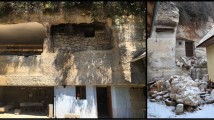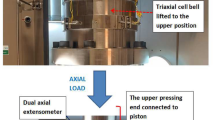Abstract
The main aim of this research is to find the most appropriate weathering indices among geomechanical, chemical and petrographical indices to characterize Malayer granitic rocks. In the study area, physical weathering and hydrothermal alteration are predominant degradation phenomena. Therefore, it is necessary to distinguish between the effect of these two phenomena and chemical weathering on mineralogy as well as on geomechanical rock properties. The most important evidences of hydrothermal alteration are the selective sericitization of plagioclase and the occurrence of prehnite. Also, statistical analyses, including simple and multiple linear regressions, were applied to identify those indices that are most influenced on the progression of weathering. Based on the simple regression analysis, petrographical and chemical indices do not show any good trend by increasing weathering degrees (R 2 < 34). Although, There are some exceptions in petrographical and chemical indices such as microfracture index (MI: R 2 = 0.68), unsound minerals (UM: R 2 = 0.67), micropetrographic index (Ip: R 2 = 0.59), and Loss on ignition (LOI: R 2 = 0.75) which are sensitive to cold climate and subtle geochemical changes due to hydrothermal alterations. Also, all geomechanical parameters are good quantitative indicators for describing the degree of weathering (R 2 > 0.72). Finally, a new quantitative weathering index (Kr4) has been developed regarding quick absorption index, P-wave velocity (Vp), point load index (Is) and total porosity (n). All the mentioned parameters can be quickly and inexpensively determined by portable laboratory instruments. This new index (Kr4) has strongly correlated with weathering degrees (R 2 = 0.96). Based on some results, it seems that Kr4 could be more suitable and credible to numerically evaluate the physical weathering accompanied by hydrothermal alteration processes of the studied rocks.





Similar content being viewed by others
References
Ahadnejad V, Valizadeh MV, Esmaeily D (2008) The role of shear zone on the emplacement of Malayer granitoid complex, NW Iran. J Appl Sci 8:4238–4250
Alavi M (1994) Tectonics of Zagros orogenic belt of Iran: new data and interpretation. Tectonophysics 229:211–238
Arel E, Tugrul A (2001) Weathering and its relation to geomechanical properties of Cavusbasi granitic rocks in northwestern Turkey. Bull Eng Geol Environ 60:123–133
Arikan F, Ulusay R, Aydin N (2007) Characterization of weathered acidic volcanic rocks and a weathering classification based on a rating system. Bull Eng Geol Environ 66:415–430
Ceryan S (1999) Weathering and classification of Harsit granitoid and the effect of weathering on engineering properties. Ph.D. Thesis, Karadeniz Technical University, Trabzon, Turkey, p 300 (in Turkish)
Ceryan S (2008) New chemical weathering indices for estimating properties of rocks: a case study from Kurtun Granodiorite, NE Turkey. Turkish I Earth Sci 17:187–207
Ceryan S (2014) New weathering indices for evaluating durability and weathering characterization of crystalline rock material: a case study from NE Turkey. Afr Earth Sci. doi:10.1016/j.jafrearsci.2014.12.005
Ceryan S, Tudes S, Ceryan N (2008a) A new quantitative weathering classification for igneous rocks. Environ Geol 55:1319–1336
Ceryan S, Zorlu K, Gokceoglu C, Temel A (2008b) The use of cation packing index for characterizing the weathering degree of granitic rocks. Eng Geol 98:60–74
Ceryan S, Tudes S, Ceryan N (2008c) Influence of weathering on the engineering properties of Harsit granitic rocks. Bull Eng Geol Environ 67:97–104
Dusgoren Aydin NS, Aydin A, Malpas J (2002) Reassessment of chemical weathering indices: case study on pyroklastic rocks of Hong Kong. Eng Geol 63:99–119
Fookes PG, Dearman WR, Franklin JA (1971) Some engineering aspects of rock weathering. Q J Eng Geol 4:139–185
Gabet EJ, Wolff-Boenisch D, Langner H, Burbank DW, Putkonen J (2010) Geomorphic and climatic controls on chemical weathering in the High Himalayas of Nepal. Geomorphology 122:205–210
Gokceoglu C, Aksoy H (2000) New approaches to the characterization of clay-bearing, densely jointed and weak rock masses. Eng Geol 58:1–23
Gupta AS, Rao KS (2001) Weathering indices and their applicability for crystalline rocks. Bull Eng Geol Environ 60:201–221
Hamrol AA (1961) Quantitative classification of the weathering and weatherability of rocks. In: Proceedings of the 5th international conference on soil mechanics and foundation engineering, Paris 2, pp 771–774
Harnois L, Moor JM (1988) Geochemistry and origin of the ore chemistry formation, a transported paleoregolith in the Greenville Province of Southeastern Ontario, Canada. Chem Geol 69:267–289
Heidari M, Momeni AA, Naseri F (2013) New weathering classifications for granitic rocks based on physico-mechanical parameters. Eng Geol 166:65–73
Hutchinson CS (1974) Laboratory handbook of petrographic techniques. Wiley, New York
Illev IG (1966) An attempt to estimate the degree of weathering of intrusive rocks from their physico-mechanical properties. In: Proceedings of 1st congress of the international society for rock mechanics, Lisbon, pp 109–114
Irfan TY (1996) Mineralogy, fabric properties and classification of weathered granites in Hong Kong. Q J Eng Geol 29:5–35
ISRM (1978) Suggested methods for determining tensile strength of rock materials. Int J Rock Mech Min Sci Geomech Abstr 15:99–103
ISRM (1979) Suggested methods for determining the uniaxial compressive strength and deformability of rock materials. Int J Rock Mech Sci Geomech Abstr 18:85–110
ISRM (1981a) Basic geotechnical description of rock masses. Int J Rock Mech Min Sci Geomech Abstr 18:85–110
ISRM (1981b) ISRM suggested methods: rock characterization, testing and monitoring: international society of rock mechanics suggested methods. Pergamon Press, London
ISRM (1985) Suggested method for determining point load strength. Int J Rock Mech Min Sci Geomech Abstr 22(2):51–60
Khanlari GR, Heidari M, Momeni AA (2012) Assessment of weathering processes effect on engineering properties of Alvand granitic rocks (west of Iran), based on weathering indices. Environ Earth Sci 67:713–725
Kilic R (1999) A unified alteration index (UAI) for mafic rocks. Environ Eng Geosci 4:475–483
Kilic R, Ulamis K, Yurdakul M, Kadioglu YK (2014) The alteration degree of the metacrystalline rocks based on UAI, Bolu (Turkey). Bull Eng Geol Environ 73:193–201
Lan HX, Hu RL, Yue ZQ, Lee CF, Wang SJ (2003) Engineering and geological characteristics of granite weathering profiles in South China. J Asian Earth Sci 21:353–364
Lee SG, De Freitas MH (1988) Quantitative definition of highly weathered granite using the slake durability test. Geotechnique 38:635–640
Liu S, Lin G, Liu Y, Zhou Y, Gong F, Yan Y (2007) Geochemistry of middle oligocene-pliocene sandstones from the Nanpu Sag, Bohai Bay Basin (Eastern China): implications for provenance, weathering, and tectonic setting. Geochem J 41(5):359–378
Lump P (1962) The properties decomposed granite. Geotecnique 12:226–243
Momeni AA, Heidari M, Khanlari GR, Sepahi AA, Bazvand E (2015) New engineering geological weathering classifications for granitoid rocks. Eng Geol 185:43–51
Naseri F (2012) The study of weathering indices and their application for Malayer Granitoid rocks. M.S. Thesis, Bu-ali Sina University of Hamedan, Iran (In Persian)
Nesbitt HW, Young GM (1982) Early Proterozoic climates and plate motions inferred from major element chemistry of lutites. Nature 299:715–717
Ohta T, Arai H (2007) Statistical empirical index of chemical weathering in igneous rocks: a new tool for evaluating the degree of weathering. Chem Geol 240:280–297
Orhan M, Isık NS, Topal T, Ozer M (2006) Effect of weathering on the geomechanical properties of andesite, Ankara, Turkey. Environ Geol 50:85–100
Parker A (1970) An index of weathering for silicate rocks. Geol Mag 107:501–504
Price JR, Velbel MA (2003) Chemical weathering indices applied to weathering profiles developed on heterogeneous felsic metamorphic parent rocks. Chem Geol 202:397–416
Reiche P (1943) Graphics representation of chemical weathering. J Sediment Petrol 13:58–68
Rocha-Filho P, Antuenes FS, Falcao MFG (1985) Quantitative influence of the weathering upon the mechanical properties of a young gneiss residual soil. In: Proceedings of first international conference on geomechanics in tropical lateritic and saprolitic soils, vol 1. Brasilia, pp 281–294
Ruhe RV (1956) Geomorphic surfaces and the nature of soils. Soil Sci 82:441–455
Ruxton BP (1968) Measures of degree of chemical weathering of rocks. J Geol 76:518–527
Sabziparvar AA (2003) The analysis of aridity and meteorological drought indices in west of Iran. Research report. Bu-Ali Sina University, Hamadan, Iran
Sepahi AA (1999) Petrology of Alvand plutonic complex with special reference on granitoids. Ph.D. thesis in Persian; Tarbiat Moallem university of Tehran, Iran
Sueoka T, Lee IK, Muramatsu M, Imamura S (1985) Geomechanical properties and engineering classification for decomposed granite soils in Kaduna district, Nigeria. In: Proceedings of first international conference on geomechanics in tropical lateritic and saprolitic soils, vol 1. Brasilia, pp 175–186
Tardy Y, Becquerel G, Paquet H, Millot G (1973) Formation of clay from granite and its distribution in relation to climate and topography. Geoderma 10(4):271–284
Ugur I, Demirdag S, Yavuz H (2010) Effect of rock properties on the Los Angeles abrasion and impact test characteristics of the aggregates. Mater Charact 61:90–96
Onodera TF, Yoshinaka R, Oda M (1974) Weathering and its relation to mechanical properties of granite. In: Proceedings of 3rd Congr Int Soc Rock Mech, Denver 2A, pp 71–78
Zhao J, Broms BB (1993) Mechanical and physical properties of weathered Bukit Timah granite of Singapore. In: Anagnostopoulos A et al (eds) Geotechnical engineering of hard soils-soft rocks. Balkema, Rotterdam, pp 883–890
Acknowledgments
This work was supported by the Bu-Ali Sina University. The authors are so grateful to Assoc. Prof. Dr. Behrooz Rafiee (Bu-Ali Sina University) for his valuable suggestions in XRD analyses.
Author information
Authors and Affiliations
Corresponding author
Rights and permissions
About this article
Cite this article
Khanlari, G.R., Naseri, F. Investigation of physical deterioration of Malayer granitic rocks using a new weathering coefficient (Kr4). Environ Earth Sci 75, 414 (2016). https://doi.org/10.1007/s12665-015-5046-7
Received:
Accepted:
Published:
DOI: https://doi.org/10.1007/s12665-015-5046-7




